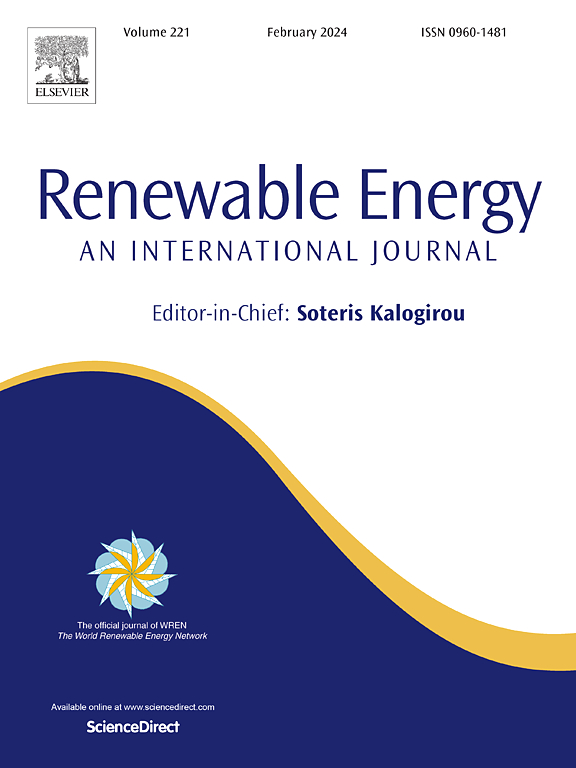Thermodynamic and environmental impact analysis of a novel solar SOFC-based zero-carbon emission CCHP system coupled with a water gas shift membrane reactor for CO2 separation
IF 9.1
1区 工程技术
Q1 ENERGY & FUELS
引用次数: 0
Abstract
To efficiently utilize solar energy and reduce energy consumption for CO2 separation, a solar-assisted solid oxide fuel cell-based combined cooling, heating, and power system integrated with a partially covered parabolic trough photovoltaic thermal collector, a water gas shift membrane reactor, and a supercritical CO2 cycle is proposed. The water gas shift membrane reactor replaces the conventional fuel cell afterburner, controlling exhaust gas composition to enrich CO2 with nearly zero energy input. Thermodynamic and environmental performances of the solar-assisted system are compared with the system without solar assistance, the oxy-fueled system, and the traditional air-mixed combustion system. The results illustrate that the solar-assisted system achieves energy efficiencies of 87.54 % in summer and 95.68 % in winter, exceeding the traditional system by 6.81 and 8.00 percentage points, respectively. The exergy efficiencies reach 57.37 % and 58.48 %, and the largest exergy losses occur in the partially covered parabolic trough collector, accounting for 27.4 % of the total, followed by the fuel cell at 14.8 %. The CO2 emission factors based on electricity, energy, and exergy are lowest for the solar-assisted system in both summer and winter. The system's power output and exergy efficiency increase with fuel cell operating temperature, while total energy output and energy efficiency decrease. Increased solar irradiation further improves electricity and total energy output. These findings indicate that coupling solar energy with a water-gas shift membrane reactor in fuel cell systems markedly improves efficiency and reduces emissions, providing a promising pathway toward low-carbon, high-efficiency energy conversion.
基于sofc的新型太阳能零碳排放热电联产系统与水气移膜反应器耦合CO2分离的热力学和环境影响分析
为了有效利用太阳能,降低CO2分离的能耗,提出了一种基于太阳能辅助固体氧化物燃料电池的冷热联产系统,该系统由部分覆盖的抛物面槽光伏集热器、水气移膜反应器和超临界CO2循环系统组成。水气转换膜反应器取代了传统的燃料电池加力燃烧室,控制废气成分,在几乎零能量输入的情况下富集二氧化碳。将太阳能辅助燃烧系统的热力学和环境性能与无太阳能辅助燃烧系统、含氧燃烧系统和传统空气混合燃烧系统进行了比较。结果表明,该系统夏季和冬季的能效分别达到87.54%和95.68%,分别比传统系统高出6.81和8.00个百分点。火用效率分别达到57.37%和58.48%,其中部分覆盖抛物面槽集热器的火用损失最大,占总损失的27.4%,其次是燃料电池,占14.8%。在夏季和冬季,太阳能辅助系统基于电力、能源和火用的二氧化碳排放因子最低。随着燃料电池工作温度的升高,系统的功率输出和能量效率增加,而总能量输出和能量效率降低。太阳辐照的增加进一步提高了发电量和总发电量。这些发现表明,在燃料电池系统中,将太阳能与水气转换膜反应器耦合可以显著提高效率并减少排放,为实现低碳、高效的能源转换提供了一条有希望的途径。
本文章由计算机程序翻译,如有差异,请以英文原文为准。
求助全文
约1分钟内获得全文
求助全文
来源期刊

Renewable Energy
工程技术-能源与燃料
CiteScore
18.40
自引率
9.20%
发文量
1955
审稿时长
6.6 months
期刊介绍:
Renewable Energy journal is dedicated to advancing knowledge and disseminating insights on various topics and technologies within renewable energy systems and components. Our mission is to support researchers, engineers, economists, manufacturers, NGOs, associations, and societies in staying updated on new developments in their respective fields and applying alternative energy solutions to current practices.
As an international, multidisciplinary journal in renewable energy engineering and research, we strive to be a premier peer-reviewed platform and a trusted source of original research and reviews in the field of renewable energy. Join us in our endeavor to drive innovation and progress in sustainable energy solutions.
 求助内容:
求助内容: 应助结果提醒方式:
应助结果提醒方式:


